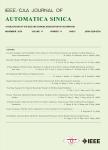Equilibrium Strategy of the Pursuit-Evasion Game in Three-Dimensional Space
作者机构:School of Artificial IntelligenceUniversity of Chinese Academy of SciencesBeijing 100049 Institute of AutomationChinese Academy of SciencesBeijing 100190China
出 版 物:《IEEE/CAA Journal of Automatica Sinica》 (自动化学报(英文版))
年 卷 期:2024年第11卷第2期
页 面:446-458页
核心收录:
学科分类:12[管理学] 1201[管理学-管理科学与工程(可授管理学、工学学位)] 07[理学] 070105[理学-运筹学与控制论] 0701[理学-数学]
基 金:supported in part by the Strategic Priority Research Program of Chinese Academy of Sciences(XDA27030100) National Natural Science Foundation of China(72293575, 11832001)
主 题:Differential game equilibrium strategy pursuit-evasion game threedegree-of-freedom control
摘 要:The pursuit-evasion game models the strategic interaction among players, attracting attention in many realistic scenarios, such as missile guidance, unmanned aerial vehicles, and target defense. Existing studies mainly concentrate on the cooperative pursuit of multiple players in two-dimensional pursuit-evasion games. However, these approaches can hardly be applied to practical situations where players usually move in three-dimensional space with a three-degree-of-freedom control. In this paper,we make the first attempt to investigate the equilibrium strategy of the realistic pursuit-evasion game, in which the pursuer follows a three-degree-of-freedom control, and the evader moves freely. First, we describe the pursuer s three-degree-of-freedom control and the evader s relative coordinate. We then rigorously derive the equilibrium strategy by solving the retrogressive path equation according to the Hamilton-Jacobi-Bellman-Isaacs(HJBI) method, which divides the pursuit-evasion process into the navigation and acceleration phases. Besides, we analyze the maximum allowable speed for the pursuer to capture the evader successfully and provide the strategy with which the evader can escape when the pursuer s speed exceeds the threshold. We further conduct comparison tests with various unilateral deviations to verify that the proposed strategy forms a Nash equilibrium.




